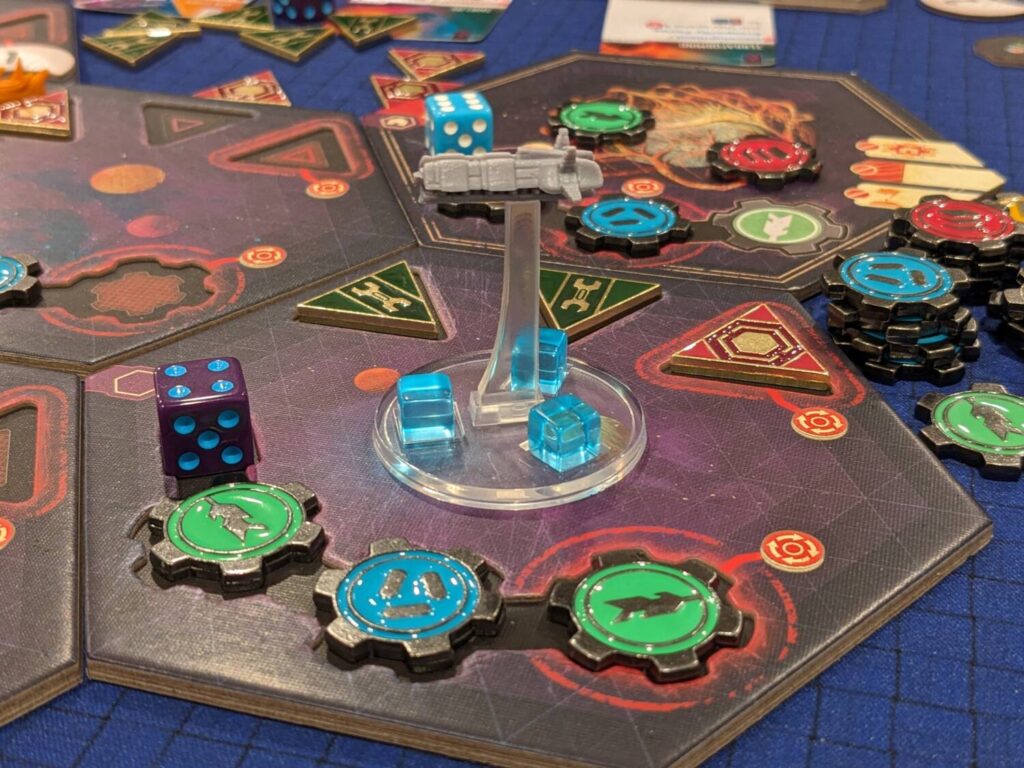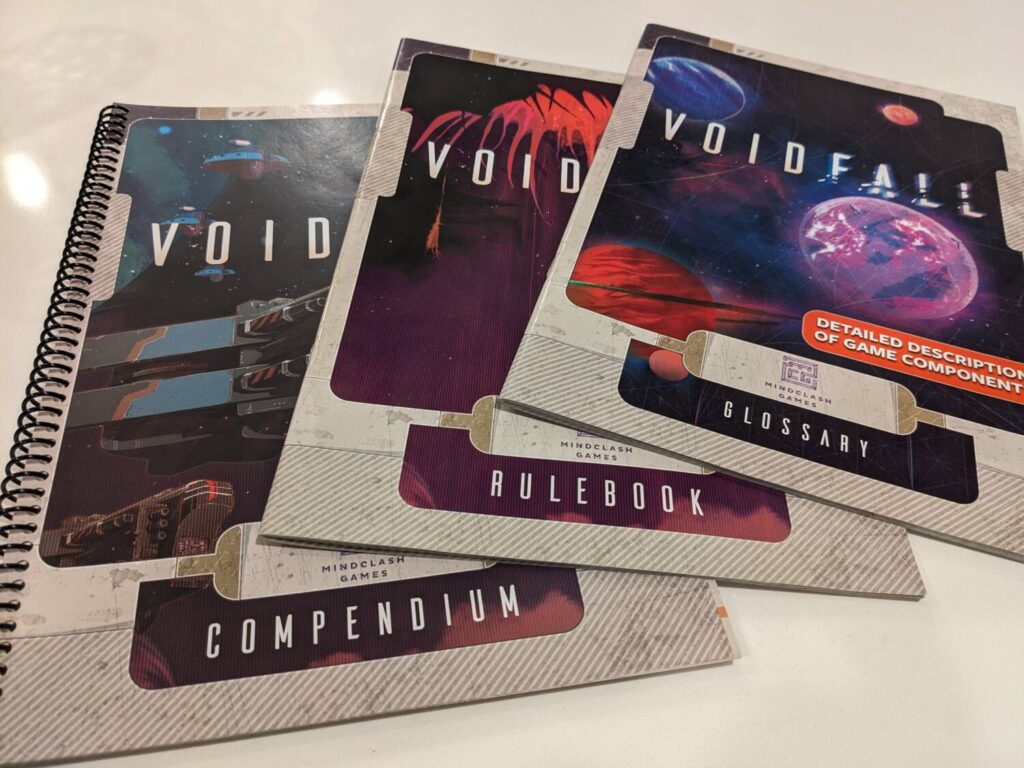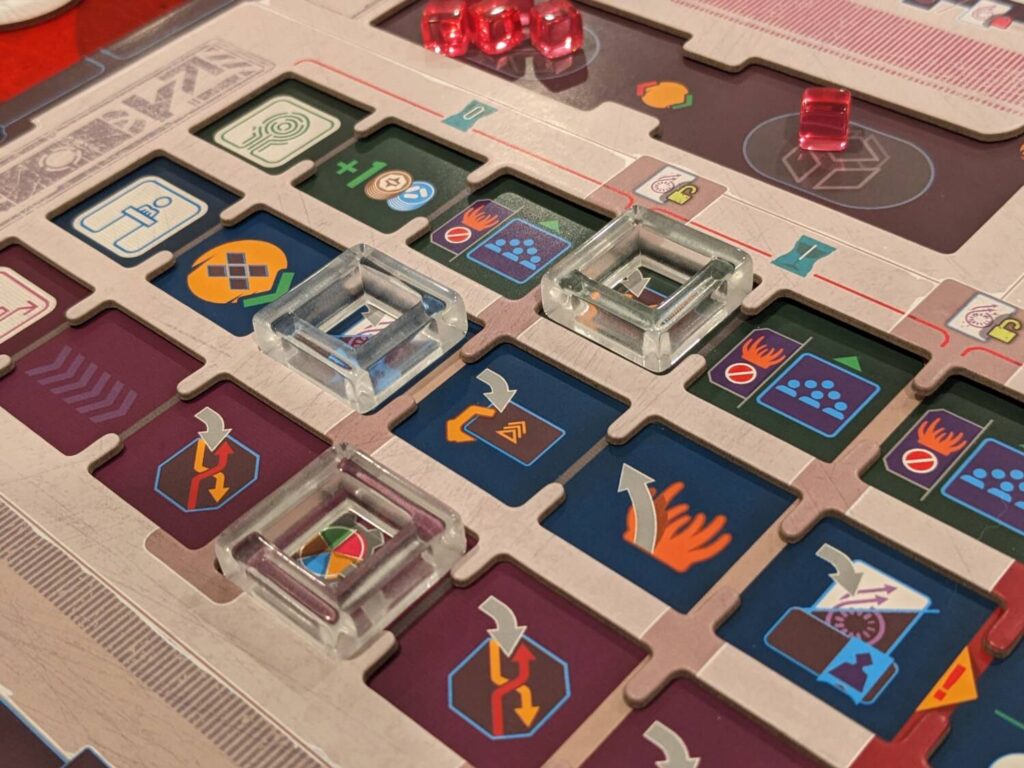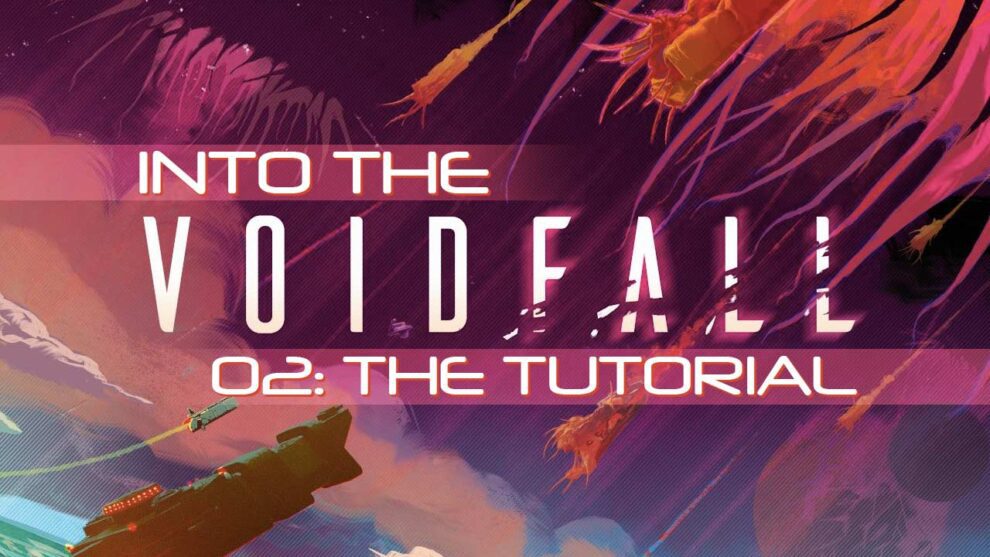After hearing from friends about their first four-player game of Voidfall, then reading more about other player experiences online, I decided to tackle Voidfall the way that made the most sense for my fairly busy gaming schedule.
And that would be to find a single person to play this game with, and against, 5-7 times. At an hour per player (the time listed on the box), I knew I could not commit to that many plays of Voidfall with four players, given the length of each game. So I started small, with a Mindclash superfan I could trust.
My buddy Alec was the perfect man for the job. He loves heavy strategy games, and Mindclash is probably his favorite publisher. Alec’s a smart guy—he knew that a few of the folks in our gaming group were already backing the Voidfall campaign, so it was easy to ensure that he didn’t need a copy of the game for himself. And if he loved the game, he could always buy a copy later for solo play.

But maybe more important than that—Alec is an excellent player who makes relatively quick decisions. When I played the Voidfall demo at SPIEL 2022, two things really struck me during a single three-card “Cycle” (round) at the demo:
- Voidfall is definitely the heaviest game Mindclash has made. This is significant because Mindclash is already well known in the tabletop industry for making highly strategic games that take hours to play.
- The downtime during the demo was hefty…real hefty. And that was in a controlled environment where our Mindclash staffer basically scripted each player’s moves.
With these things in mind, I reached out to Alec once my November and December schedules came into focus. We arranged to play Voidfall once a week for the final seven weeks of the year, knowing that we might have to cancel once or twice for life stuff. Alec also agreed to watch the 63-minute teach video and read the entire rulebook (i.e., rules compilation one of three in the box, not including the Glossary and the “Compendium”, which includes all of the game’s 40+ scenarios). This ensured I could avoid the worst thing about Voidfall—trying to teach it to another person.
In this way, Alec and I basically got Voidfall-married a few weeks ago. This level of commitment was the only way to properly dive into the most complex game I have picked up this year.
With this in place, we set up our first session: the two-player Voidfall tutorial.

The Set-Up Is No Joke
On the day of our tutorial, I was set to have a busy work day so I decided to set up the game the night before, around 11 PM.
When the smoke cleared, I didn’t get to bed until 1:15 AM.
The first time you set up Voidfall, it takes a while because of all the bits you’ve got to arrange…Installation tokens, plastic ships, cardboard tokens, etc. Then you’ve got to figure out the iconography for the setup diagrams of the game’s tiles. There are 30 sector and home tiles that have to be sorted, then built into a hexagonal map. Ships need to be set on plastic stands, with “Fleet Power” (strength) cubes placed on each stand.
Resource boards have to be set up. Factions are selected, then technologies are arranged in a display along with the Agenda board. These Agendas, which are used for end-game scoring, have to be shuffled and sorted too. Event cards, known as Galactic Events (“galactic”…there’s that word again), usually have to be shuffled and sorted into three piles. In the tutorial, you get a break—three specific Galactic Events are used for the three Cycles of the tutorial scenario.
I set up both of the player areas for our two starting factions: House Cortozaar and House Dunlork. Setting up each faction with their starting production was also a minor to-do. Of course, I really did this because I wanted to slide those sweet, sweet player mats into the triple-layer player boards. Then, I realized that all of the intel on how to play each faction is on the back of those sheets…which I had just covered by sliding the mats into the boards. So I pulled the mats out again to make sure Alec and I could study up before the game.
All of this setup was for a competitive two-player game. If you can believe this, the co-op/solo setup is SIGNIFICANTLY longer, so much so that the setup guide recommends that you’ll want to play Voidfall competitively a couple times before trying the co-op.
Oh boy. The rules overhead and game setup is, collectively, a beast. Still, I’m pleasantly surprised to share that despite all of the hours spent on the front end, it only took two hours and fifteen minutes to play the tutorial scenario.

Guard Rails
The goal of the tutorial is simple: finish the game knowing what the heck you are supposed to be doing. Let’s give credit where credit is due: this is one of the best tutorials I have ever played.
The tutorial also created some interesting questions at the end, which we’ll circle back to later.
The tutorial is really streamlined across the three Cycles/rounds. In Cycle one, build up your production engine. In Cycle two, get into some combat with neighboring Voidborn-controlled sectors, while advancing into the midrange portions of at least one of the three Civilization tracks on your player mat. In Cycle three, focus on gaining one or two more Agenda cards that can help score a bounty of end-game points. Most of this will take place in a competitive race to score the most points (points here are known as Influence), but you might get to take a swing at an opponent in combat by the final action or two of the tutorial.
Cycle one of the tutorial is basically on rails. The first Galactic Event card forces players to discard all but three of their Focus cards for the game’s first three actions.
Focus cards are the crux of Voidfall. On a turn, a player has to play one of their Focus cards and take two of the three actions listed on their chosen card. You might get a chance to play all three actions with Trade tokens that are acquired during play, but usually you’ll only take two actions each turn.
We found that the order in which someone plays their first three Focus cards in the tutorial matters a little—I wanted to up my production, so I played the Development Focus card to take the Harmonize action, increasing my production in a “Pure” sector under my control. But generally, there’s not a wrong way to play that first round. It’s a learning game, right? And you are going to have to play all three of the Focus cards anyway.
As House Cortozaar, I focused on increasing my Economy Civilization track, so I spent a little time in the first two Cycles bumping that track to get more Trade tokens. All of the Focus card choices were so juicy! And I love that most actions on Focus cards have a small but meaningful cost, adding to the tension. Some actions, particularly actions that produce more stuff, are free. But all of the best actions cost something, and those choices create intrigue!!
Moving through the Cycles, the tutorial slowly opened up more cards to choose from while also increasing the number of turns in a round, from three turns in Cycle one to five turns in Cycle three. It felt like the appropriate ramp-up, in part because you are going to agonize over every card played in the third Cycle. Or at least we did, and for two people usually not afflicted with “analysis paralysis” or AP, we found ourselves taking turns lasting 4-6 minutes in that third cycle.
Voidfall is already in the running as a classic in the hand management space. You can only play each of your Focus cards once per Cycle, with one card (Innovation) not available until the second Cycle because it begins play in your discard pile. The choices here are very tough, and for some players, the AP associated with making choices will make Voidfall a non-starter. I can already think of people who I would NEVER play Voidfall with for this reason.

How Close Was That Ending?
Throughout play, it was fun to see each of us complete big turns.
Alec strung together big combat victories over Voidborn fleets that earned him double-digit points. I was able to acquire an Agenda card that combined really nicely with my starting Agenda’s scoring goal of building lots of Shipyards on my controlled sectors, so I scored a bunch of points during the game and at the end for that combo.
Alec had some cool tech, including Deep Space Missiles that helped to end two of his combat situations without any loss of his House Fleet Power. I began the game with Torpedoes; later, I acquired Decontamination Chambers, which let me stash Corruption that I picked up during the game on that card. My Autonomous Drones allowed me to invade a neighboring sector with a small Corvette Fleet late in the game.
Back and forth it went, and when the game was over, I knew it would be close, within a few points for sure. As it turned out, it was razor-thin: 173 for Alec, 172 for me. And even though we were knee deep in the rulebook throughout the game, checking the definition of some symbols in the Glossary or making sure we had the setup right in the Compendium, we still finished in just over two hours.
And the sense of accomplishment is pretty grand. Even in defeat, I was struck by how much I enjoyed trying to optimize my 12 turns. Also, I felt like the sectors in my half of the game’s galaxy were completely different by the end of the game. My food production had actually overproduced in the game’s final round; overproduction scores extra points if you produce more than your stockpile capacity.
One could tell that Corruption, in particular, was really scaled out of the tutorial scenario. As the name implies, Corruption is generally negative for a player; it kills off the ability to earn points and/or bonuses, depending on where it resides on your player board. You can take a little Corruption here and there, but clearing it within the same cycle is usually the best course of action.
The addition of Corruption will lead to some nice tension in future plays. And we didn’t use any of the sexy fleet tech that would have added Sentries or Dreadnaughts to our game. I expect combat in future games to be much more interesting, but the tutorial did a nice job of setting the table.

Is Voidfall a bit too much of a multiplayer solitaire puzzle? In the tutorial, yes. I expect to prefer more aggressive scenarios in competitive play moving forward, ideally on smaller maps so that I can “reach out and touch someone” more consistently. I really like the Euro aspects of the Voidfall design. The tracks are great, even for the basic factions (including the two we used for the tutorial, as recommended). The tech tableau and the Agenda card display choices were interesting and I love the pursuit of personal milestones so that I can tailor my experience how I like. Spiking production in certain areas to ensure that end-of-round upkeep is easy was also very satisfying.
I already know I will try to avoid four-player games of Voidfall. More players means more downtime, particularly later in games. Watching other players take their time thinking (and not doing) when I have a good sense of what I want to do next? Nah, I’m good.
Alec and I were both surprised by one other element. I am sure Mindclash felt that Voidfall should be a sort of magnum opus, in terms of the kitchen sink aspects of what’s here. Voidfall might be the only game some people play next year, because there is so much game in this box.
It’s shocking, really. I would happily play the tutorial again 3-4 times and certainly have fun doing it. If the game only had five scenarios—or better yet, no scenarios, and just a big galactic board that could be developed through play and not specific setup conditions—then Voidfall would be more than enough game for 90% of the people I know.
And that’s if you only had four included factions, not the FOURTEEN the game actually has.
Voidfall is the new standard-bearer for “this goes above and beyond my wildest expectations”, in terms of the value proposition. I’m surprised I haven’t read any content using this reference, but Voidfall is the same as Gloomhaven in this capacity. You could spend 100 hours with Voidfall, and only begin to see what it has to offer, particularly when considering the competitive and co-op setups, the technologies available in each game, and the different Houses.
I’m going to play Voidfall 14 times, once with each faction, before finalizing my review. That will take the rest of the year, but it’s an endeavor that I feel gives me the best chance to scratch the surface of the game’s potential. I often wonder if many players will see Voidfall on their table as often as I will, to really ensure they are getting their money’s worth!











Look forward to seeing more of your thoughts on this incredible masterpiece of a game! It is truly David’s magnum opus
Oh my! The first article piqued my interest. This one has me salivating.
Really looking forward to more!